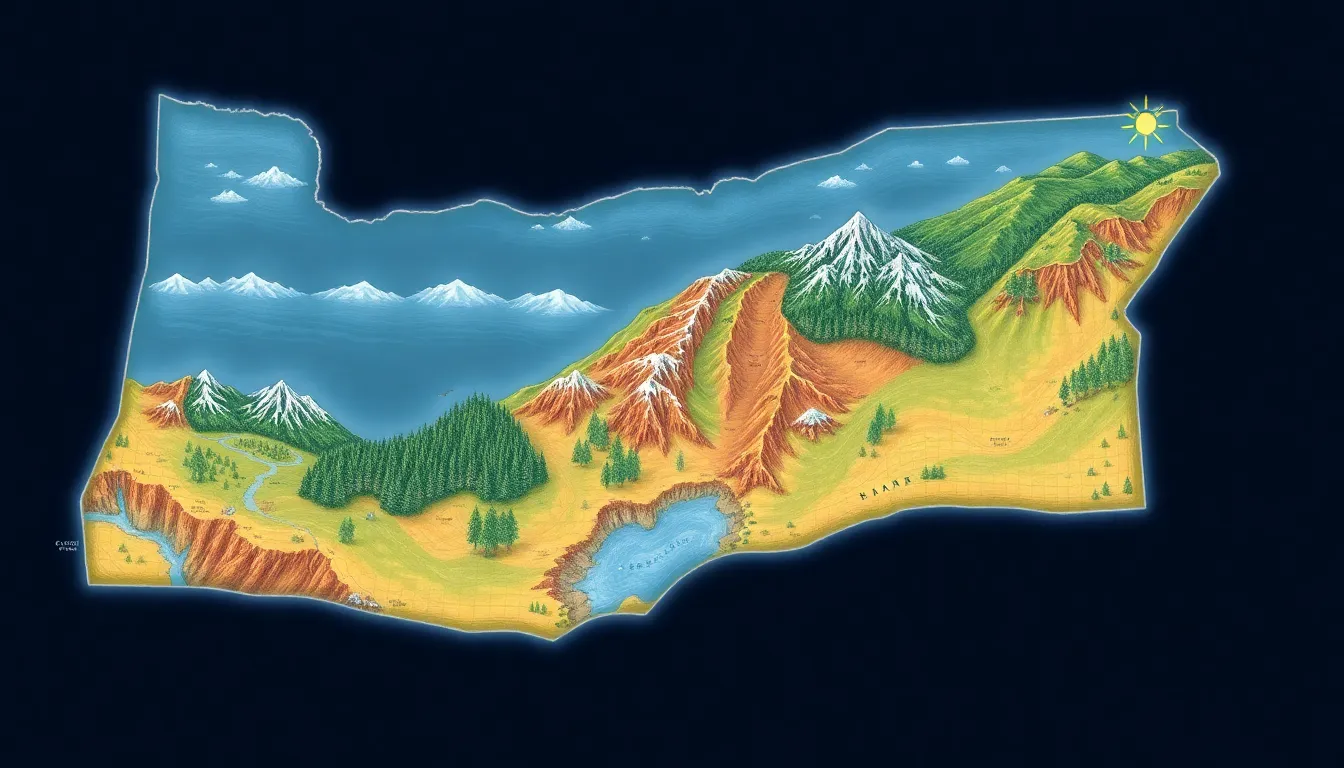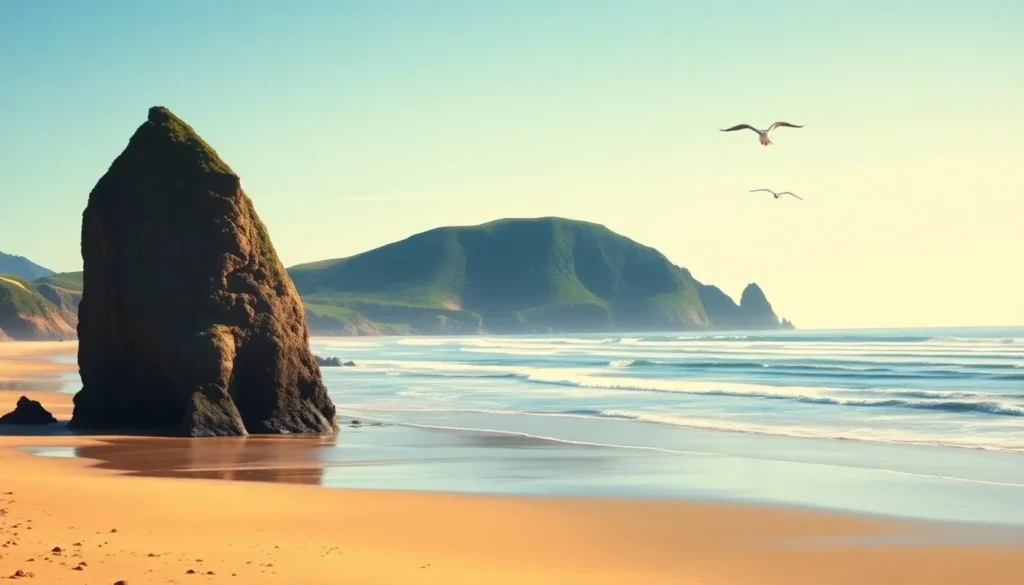Table of Contents
ToggleOregon might just be the best-kept secret on the West Coast. Nestled between the Pacific Ocean and the majestic Cascade Mountains, this gem is often overshadowed by its flashier neighbors. But don’t let that fool you; Oregon’s got everything from stunning coastlines to lush forests, and yes, even a thriving coffee culture that could rival Seattle’s.
If you’re pondering where exactly Oregon is on the map, you’re not alone. Many folks can point out New York and California without breaking a sweat, but Oregon? It’s like that cool kid in class who’s a little harder to pin down. Join the adventure as we explore not just where Oregon is, but why it deserves a spot on your travel bucket list. Who knows? You might just find yourself daydreaming about those picturesque landscapes and quirky towns.
Overview of Oregon
Located in the Pacific Northwest, Oregon boasts a diverse geographical landscape that includes mountains, forests, and coastlines. Known for its stunning natural beauty, it features the Cascade Range, a volcanic mountain range that stretches from the north to the south. Along the coast, travelers can find picturesque beaches, such as Cannon Beach and Coos Bay, offering sweeping ocean views and unique rock formations.
Portland, the state’s largest city, represents a cultural hub with its vibrant arts scene and renowned food culture. Craft breweries and coffee shops thrive, reflecting the state’s commitment to quality and creativity. Various regions within Oregon, like the Willamette Valley, provide fertile ground for agriculture, especially vineyards and farms producing exceptional wines and fresh produce.
In terms of wildlife, Oregon is home to diverse ecosystems and national parks. Crater Lake National Park, famous for its deep blue water and impressive caldera, attracts nature lovers and photographers year-round. Various hiking trails wind through lush forests, showcasing the rich biodiversity of the area.
Accessibility plays a vital role in exploring Oregon. The state has major highways and interstates, connecting it to neighboring states such as Washington and California. Air travel options are available through several regional airports, including Portland International Airport.
Overall, Oregon presents a treasure trove of experiences for outdoor enthusiasts, food lovers, and those seeking cultural enrichment. With its unique offerings and hidden gems, it stands out as a must-visit destination on the West Coast.
Geographic Location

Oregon lies in the Pacific Northwest region of the United States. Notable for its diverse landscapes, the state boasts stunning coastlines, majestic mountains, and lush forests.
Bordering States
Oregon shares borders with four states. Washington lies to the north, while California is to the south. Nevada borders Oregon on the southeast, and Idaho borders on the east. Each neighbor contributes to Oregon’s unique cultural and geographical characteristics. This strategic location enhances access to various recreational and urban experiences within the region.
Key Coordinates
Key coordinates pinpoint Oregon at approximately 43.8041° N latitude and 120.5542° W longitude. These figures place Oregon within a unique geographical context. The state’s vast expanse covers more than 98,000 square miles. Specific coordinates help identify not only the state itself but also its proximity to landmarks and cities, including Portland and Crater Lake National Park. Recognizing these coordinates enriches understanding of Oregon’s placement on both state and national maps.
Oregon on the U.S. Map
Oregon’s unique location in the Pacific Northwest makes it a vital part of the region, showcasing diverse landscapes and attractions.
Placement in the Pacific Northwest
Oregon occupies a central position in the Pacific Northwest. It borders Washington to the north and California to the south, offering a natural transition between coastal and mountainous regions. To the east, Idaho provides a scenic backdrop, while Nevada lies to the southeast. This strategic placement enhances Oregon’s access to both urban centers and outdoor adventures. Comprised of diverse ecosystems, Oregon features coastal beaches, dense forests, and the Cascade Range mountains. Coordinates pinpoint Oregon at approximately 43.8041° N latitude and 120.5542° W longitude, highlighting its distinct geographical positioning within the U.S.
Major Cities
Major cities like Portland and Eugene play significant roles in Oregon’s identity. Portland, the largest city, thrives as a cultural hub with vibrant arts and music scenes. Known for its extensive parks and food culture, it boasts numerous craft breweries and renowned coffee shops. Eugene ranks as another prominent city, celebrated for its connection to the University of Oregon. Its lively community is enriched by an array of events, including arts festivals and outdoor activities. Smaller cities like Salem and Bend contribute unique flavors, each offering local attractions and charming atmospheres. All these urban centers collectively enhance Oregon’s appeal to diverse visitors.
Importance of Oregon’s Location
Oregon’s strategic location significantly influences its economy and culture.
Economic Impact
Oregon’s proximity to the Pacific Ocean enhances trade opportunities, especially in the shipping industry. Ports in cities like Portland and Coos Bay facilitate the movement of goods, contributing to financial growth. Agriculture thrives due to fertile soil in the Willamette Valley, producing high-quality crops and wines. Technologies, including companies in tech hubs like Hillsboro, benefit from skilled labor and access to innovation. Tourism, spurred by landmarks like Crater Lake, adds substantial revenue as visitors flock to explore diverse landscapes and activities. The state’s geographic features encourage outdoor recreation, creating jobs in hospitality and services. Overall, location plays a critical role in shaping Oregon’s economic landscape.
Cultural Significance
Oregon’s geographical diversity fosters rich cultural experiences. Coastal regions offer unique maritime traditions, while the Cascade Range influences community events centered on outdoor activities. Cities like Portland are known for their vibrant arts scene, showcasing local talent and diversity. Cultural festivals celebrate heritage and environmental awareness, promoting an appreciation for the state’s natural beauty. The wine country attracts connoisseurs and casual visitors alike, blending culinary experiences with scenic views. Historically, Indigenous tribes have shaped the region’s identity, contributing to Oregon’s rich tapestry of stories and traditions. This interconnectedness enhances the cultural landscape, making it a thriving hub for arts, cuisine, and heritage.
Oregon stands out as a captivating destination that combines natural beauty with cultural richness. Its diverse landscapes and vibrant cities offer something for everyone. Whether it’s the stunning coastlines or the thriving arts scene in Portland, Oregon invites exploration and adventure.
The state’s strategic location in the Pacific Northwest enhances its appeal, making it easily accessible for travelers. With a blend of outdoor activities and culinary delights, Oregon’s charm is undeniable. This hidden gem deserves a spot on any travel itinerary, promising unforgettable experiences and lasting memories.





